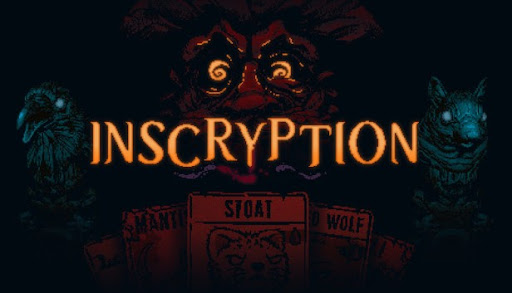New horror game Inscryption and what makes it stand out

https://store.steampowered.com/app/1092790/Inscryption/
February 4, 2022
Modern horror games have trended into rather boring, cookie-cutter experiences filled with cheap scares and underwritten villains and monsters, with only the occasional game breaking the mold and giving players something new and fresh. In late 2021, just before Halloween, Inscryption slid mostly under the radar, advertised as a simple strategy deck-building game with a darker theme to it. When I first saw Inscryption, it was when Markiplier, a prominent Let’s Play Youtuber, made his first video regarding the uniquely twisted card game. Immediately following this, I purchased the game and played through it for myself. I found three different prominent aspects of its story and style that make Inscryption a unique and fun experience.
Quick warning: this review will contain minor spoilers for the game’s story as well as the structure of the game and its three acts.
The first aspect I noticed becomes apparent with the game’s cold-open: the narrator acts as if you, the player, are returning to the game after a small hiatus despite you having only just started Inscryption for the first time. One of the fundamental reasons for this game’s success, or the success of any decent horror experience, is the game’s absence of information. This first act revolves nearly entirely around this absence of information, leaving the player to piece things together with virtually no narrative exposition to give a solid foundation, increasing the mystery of the game’s overall purpose.
During the ending of the first act, you begin to learn small story-significant details through pre-recorded videos by a secondary person. At the same time, it is revealed that your playthrough of Inscryption is nothing more than another one of these videos, this time in a long-form style, that you are watching play out before you. Each subsequent act revolves around a different set of information than the last, allowing you to learn more about the previous acts while still lacking in the information you need to fully understand the mystery unfolding before you.
The second piece to this puzzle is the game’s usage of calm description and narration to refer to relatively disturbing concepts. One example of this is the Mycologists: over the course of the first act, you are led to believe that the cards you are using, each depicting a certain animal, have some form of life. This makes things even darker when you meet the Mycologists, who will empower one of your cards by adding two duplicate cards you own together. They ask you to look away, but the splatters of red and shredded pieces of card that fly past the screen mixed with the grotesquely-squishy sounds of their saw cutting into the cards create a creepy scene that is presented as an entirely normal part of the gameplay and experience.
Finally, the game’s use of things existing in the real world adds an even deeper level to the story and mystery of the game. Within the previously mentioned videos, you follow the story of a YouTube card-game pack opener, The Lucky Carder. He slowly begins to unravel a plot that involves company-level corruption, cover-ups, and mysterious deaths, all recorded through the same video camera used by the YouTuber to film his videos. This addition of “real” videos alongside factors like corruption and cover-ups that happen commonly in the real world (albeit to a much smaller degree than the company shown in the game) grounds this game within realism.
All in all, if you’re looking for a fun, slightly difficult, and unique horror game experience, Inscryption is a wonderful game to check out, and probably my favorite game of 2021.



